Battling Bicarbonates
Kevin Breen, Lahontan Golf Club, Truckee, CA:
 "Our irrigation water comes from deep wells on the Lahontan site. Very pure clean water with little electrical conductivity, which is a measure of salts. The one thing that it does have is bicarbonate (CaCO3), and this is a recipe for creating a sink for salt development in our soils. To combat the accumulation of bicarbonate and a pH above 8 in our water, we add gypsum to our irrigation ponds, inject acids into our irrigation system, apply fertilizers with acidifying characteristics, and flush our greens regularly. Flushing assists in the removal of salts and wets the entire soil profile consistently and deeply.
"Our irrigation water comes from deep wells on the Lahontan site. Very pure clean water with little electrical conductivity, which is a measure of salts. The one thing that it does have is bicarbonate (CaCO3), and this is a recipe for creating a sink for salt development in our soils. To combat the accumulation of bicarbonate and a pH above 8 in our water, we add gypsum to our irrigation ponds, inject acids into our irrigation system, apply fertilizers with acidifying characteristics, and flush our greens regularly. Flushing assists in the removal of salts and wets the entire soil profile consistently and deeply.
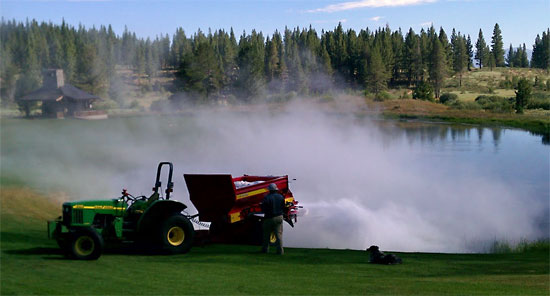
Ten tons of gypsum added to the 12th pond. |
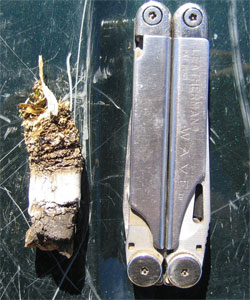
Eight years after application, lime has yet to solublize. |
The soil is tested throughout the year, and through the years we have learned that although our pure water looks pretty good on paper, in actuality it is difficult to keep things growing using this water once the bicarbonate starts to react with the calcium, phosphorous and other nutrients in the soil that the turf is needing.
There is a constant struggle to maintain good soil structure, and its importance cannot be over-emphasized because the soil is where the plant grows. The soils on the courses have come a very long way since the course was built. Hundreds of thousands of tons of lime, gypsum, composts, and sands have gone into raising the quality tremendously."
Visit Kevin's blog at lahontanmaintenance.blogspot.com/
|
 |
Bird House Success
Scott Phelps, CGCS, Newcastle Golf Club, Newcastle, WA:
 "The second year of our bird house program has again been a big success. In the spring of 2010 we had the Boy Scouts from Troup 477 build over two dozen bird houses. The golf club provided most of the materials, cut the wood to size and provided direction on how to assemble them. I also gave a brief educational lecture on the types of bird species we were looking to attract and the significance of the design of the bird houses.
"The second year of our bird house program has again been a big success. In the spring of 2010 we had the Boy Scouts from Troup 477 build over two dozen bird houses. The golf club provided most of the materials, cut the wood to size and provided direction on how to assemble them. I also gave a brief educational lecture on the types of bird species we were looking to attract and the significance of the design of the bird houses.
Many people do not realize that the shape of the entry hole and the size of the hole have a significant effect on the species that will use it and on the success of rearing chicks. 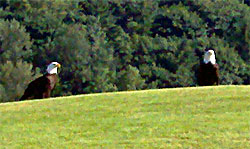 Our most successful box has been the one just outside of the entry to our maintenance facility in our bee and butterfly garden. We have had over a dozen chickadees emerge from that house alone. The other houses on the course have had varying success. Some have not had any birds in the two years and some have had chicks one year and not the next. We continue to monitor the houses weekly throughout the summer to see which ones are more successful. From this info we will move unsuccessful houses to environments, heights, directions, and cover that are similar to our inhabited boxes. Our most successful box has been the one just outside of the entry to our maintenance facility in our bee and butterfly garden. We have had over a dozen chickadees emerge from that house alone. The other houses on the course have had varying success. Some have not had any birds in the two years and some have had chicks one year and not the next. We continue to monitor the houses weekly throughout the summer to see which ones are more successful. From this info we will move unsuccessful houses to environments, heights, directions, and cover that are similar to our inhabited boxes.
Please note the two small birds pictured above were not raised in our Chickadee boxes. They were seen last week enjoying the sunshine on #1 Fairway on China Creek. It sure is a beautiful sight to see. I know all of you golfers are out there seeking other kinds of birdies and eagles but this double eagle makes you want to slow down and enjoy some of the other beautiful things you can see on a golf course.
Visit Scott's blog at newcastleturf.blogspot.com/
|
 |
Why are you putting more sand in the bunkers?
Matt Ceplo, CGCS, Rockland Country Club, Sparkill, NY:
 "Some welcome recent rains washed out a few areas in our bunkers so we decided to check sand levels as we fixed the washouts. We maintain 4 inches of sand.
"Some welcome recent rains washed out a few areas in our bunkers so we decided to check sand levels as we fixed the washouts. We maintain 4 inches of sand.
Where does the sand go? Believe it or not most of it is hit out during play. A very good example is the irrigation head on the left side of the tenth green. When constructed, the irrigation head was at ground level. It now sits ten inches below grade. The photo of the sand probe shows how much sand has been blasted out of the bunker, raising the lip a good foot or so.
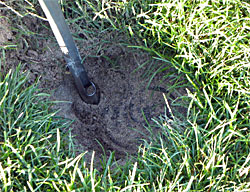
Irrigation head buried by blasted sand. |
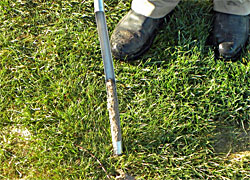
Sand from bunker has raised lip by 12".
|
We need to keep the sand at a consistent level for playability. The new sand will firm up within a week or so. In the meantime you may get a plugged ball here or there. While no one likes plugged balls, we do everything possible to prevent them. However, they are part of the game and bunkers are supposed to be hazards."
Visit Matt's blog at rocklandcountryclub.blogspot.com
|
 |
Carpet Stain
Craig DeJong, Hendersonville (NC) Country Cbub:
 "Once in a great while our equipment malfunctions. All of our staff members are taught how to react when a piece of equipment experiences a problem. Fortunately, this does not happen too often. However, it happened a few days ago when one of our fairway units sprung a hydraulic leak. "Once in a great while our equipment malfunctions. All of our staff members are taught how to react when a piece of equipment experiences a problem. Fortunately, this does not happen too often. However, it happened a few days ago when one of our fairway units sprung a hydraulic leak.
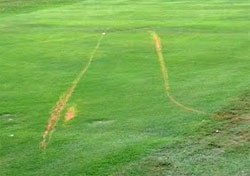 Despite the fact that a fairway is burned from the hot hydraulic oil, all parties involved responded perfectly. The operator was paying attention and quickly pulled off the fairway and onto the cart path. Our equipment technician got the unit back to the shop, had a new hydraulic hose fabricated and installed, and we were back in business in about three hours. Great teamwork!
Despite the fact that a fairway is burned from the hot hydraulic oil, all parties involved responded perfectly. The operator was paying attention and quickly pulled off the fairway and onto the cart path. Our equipment technician got the unit back to the shop, had a new hydraulic hose fabricated and installed, and we were back in business in about three hours. Great teamwork!
Visit Craig's blog at hccgcgd.blogspot.com.
|
 |
The Fine Art of Handwatering
Josh Clevenger, Claremont Country Club, Oakland, CA:
"I received the question yesterday: Why do you do all this handwatering? There are many different reasons why we handwater. The fact is that no irrigation system is perfect and to provide the consistent playing conditions that we strive for daily, we must do some amount of handwatering.
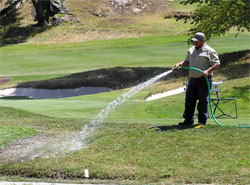 Our number one goal in the turf department is plant health. Our philosophy with regard to irrigation is deep and infrequent. For the course at Claremont this means a heavy or "deep" irrigation cycle every 7 to 10 days where we water the golf course to the equivalent of 1/4" to 1/2" of rain. In between these deep watering's, we supplement the areas that need extra water with area specific irrigation and handwatering. Our number one goal in the turf department is plant health. Our philosophy with regard to irrigation is deep and infrequent. For the course at Claremont this means a heavy or "deep" irrigation cycle every 7 to 10 days where we water the golf course to the equivalent of 1/4" to 1/2" of rain. In between these deep watering's, we supplement the areas that need extra water with area specific irrigation and handwatering.
The deep and infrequent program does many good things for plant health and for the playability of the golf course. First and foremost deep watering promotes deep rooting and in turf, it's all about the roots. With water comes oxygen and when we water deep enough we actually pull oxygen into the rootzone. As the water moves down through the soil profile, we allow the surface to "dry down" and in turn, the roots of the plant go down searching for that water. Deep Roots = Good Turf.
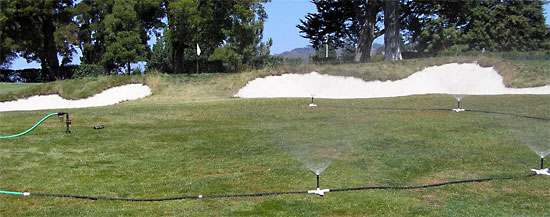
Micro sprinklers set up in the rough. |
A wise old superintendent once told me that if you are not handwatering, you're over watering. We could just turn on the irrigation every night, water enough to keep things green and go home at 2:30. This promotes a shallow root system and in turn, turf that will not hold up to the stresses that we put it through daily. The move for golf courses to use less water and promote firm and fast conditions is not just good for playability but good for the environment. Remember, a little brown grass is OK. Thanks and we'll see you on the course."
Visit Josh's blog at claremontturf.blogspot.com
|
 |
|
About our Blog Aggregator: Many superintendents are now hosting private blogs to better communicate with their golfers and/or members. Beyond local weather and course conditions, there is a great deal of information about projects, methodologies and techniques that would be of value to other superintendents — hence our Turf Blog Aggregator. As every blogger struggles occasionally with content, we also include posts intended to educate golfers about turf maintenance for others to use as a template for their own blogs.
TurfNet members: Want to share something from your blog? Send us the link.
Miss any previous issues of TBA? You can find them all here.
Turf Blog Aggregator(TM) is a trademark of Turnstile Media Group.
|
|